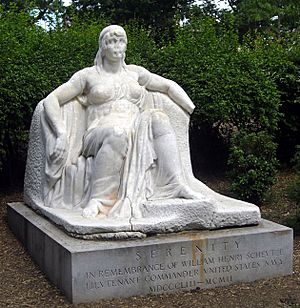Serenity (Clara) facts for kids
Quick facts for kids Serenity |
|
|---|---|
 |
|
| Artist | Josep Clarà i Ayats |
| Year | 1916–1925 |
| Type | Marble |
| Dimensions | 200 cm × 160 cm (79 in × 64 in) |
| Location | Washington, D.C., United States |
| 38°55′19″N 77°2′10″W / 38.92194°N 77.03611°W | |
| Owner | National Park Service |
Serenity is a beautiful public sculpture located in Meridian Hill Park in Washington, D.C., United States. It was created by a talented artist named Josep Clarà i Ayats from Catalonia, Spain. He lived from 1878 to 1958. This artwork was first studied by the Smithsonian's Save Outdoor Sculpture! program in 1993.
Contents
What the Serenity Sculpture Looks Like
This large sculpture shows a woman who represents a big idea or feeling. She wears long, flowing robes like people wore in ancient times. These robes are tied around her waist.
The woman has long hair and looks straight ahead with a serious expression. She sits on a rocky ledge, with her arms resting easily on the rocks behind her. Her left foot is placed on a broken sword.
Artist's Signature and Inscription
The artist, Jose Clara, signed his name on the left side of the sculpture.
The front of the base has a special message carved into it. It says:
- SERENITY
- IN REMEMBRANCE OF WILLIAM HENRY SCHEVTZE
- LIEVTENANT COMMANDER VNITED STATES NAVY
- MDCCCLIII–MCMII
It's interesting to note that the name "Schuetze" is spelled incorrectly on the monument. It should be "Schuetze," not "Schevtze."
Art Style of Serenity
The Serenity statue is a great example of the "avant-garde classical style." This art style became popular in Europe and the United States around 1910. It was inspired by the work of a French sculptor named Aristide Maillol.
This style uses classic features and simple, strong shapes. It was very important in Catalonia, where Clarà was born. There, it was part of a movement called Noucentisme, which lasted from 1910 to 1936.
The Story Behind Serenity
Serenity was bought by a man named Charles Deering in Sitges, a town near Barcelona, Spain. Deering had a special art collection that included many works by artists from Catalonia.
In 1916, Deering asked sculptor Josep Clarà i Ayats to create a version of Serenity. He wanted it for the main patio of his home in Sitges, called Palau de Maricel.
Why Serenity Came to Washington, D.C.
Later, changes to Deering's building meant the statue couldn't go there. So, he decided to place it at Meridian Hill Park. It was a way to honor his friend and classmate from the U.S. Naval Academy, William Henry Scheutze.
The sculpture was officially dedicated on March 12, 1924. William Henry Schuetze was a naval officer. He graduated from the academy in 1873. He served as a navigator on the U.S.S. Iowa during the Spanish–American War.
He was also active in the U.S. Naval White Squadron in Chicago. Earlier in his career, he was a lieutenant on missions after the difficult Jeannette expedition in the Arctic Ocean. This was even mentioned by President Chester A. Arthur in a speech.
Other Versions of Serenity
There is another sculpture similar to Serenity in the Miramar Gardens in Montjuïc, Barcelona. The Museu de la Garrotxa d'Olot also has other versions of this artwork.
Condition and Challenges for Serenity
When the sculpture was put in Meridian Hill Park in 1925, some people did not like it. They even created a petition against its placement. Some people thought the woman's "thighs were too big."
Sadly, some community members used hammers to damage the sculpture. They created small dents on the woman's face, which you can still see today.
Damage Over Time
In 1960, it was reported that the sculpture was missing its nose. When experts checked the sculpture in 1993, they said it needed repairs.
By 2009, news reports said that the sculpture was also missing her left hand and a big toe. As of 2018, one of the sculpture's hands is still missing.
Gallery
-
Serenity (Serenitat /Serenidad) by Josep Clarà i Ayats, in the Miramar Gardens of Montjuïc, Barcelona. Made in 1929 for the Barcelona International Exhibition.
-
Ramon Casas, Portrait of Josep Clarà, 1904–1905. This painting is at the Museu Nacional d'Art de Catalunya, Barcelona.





